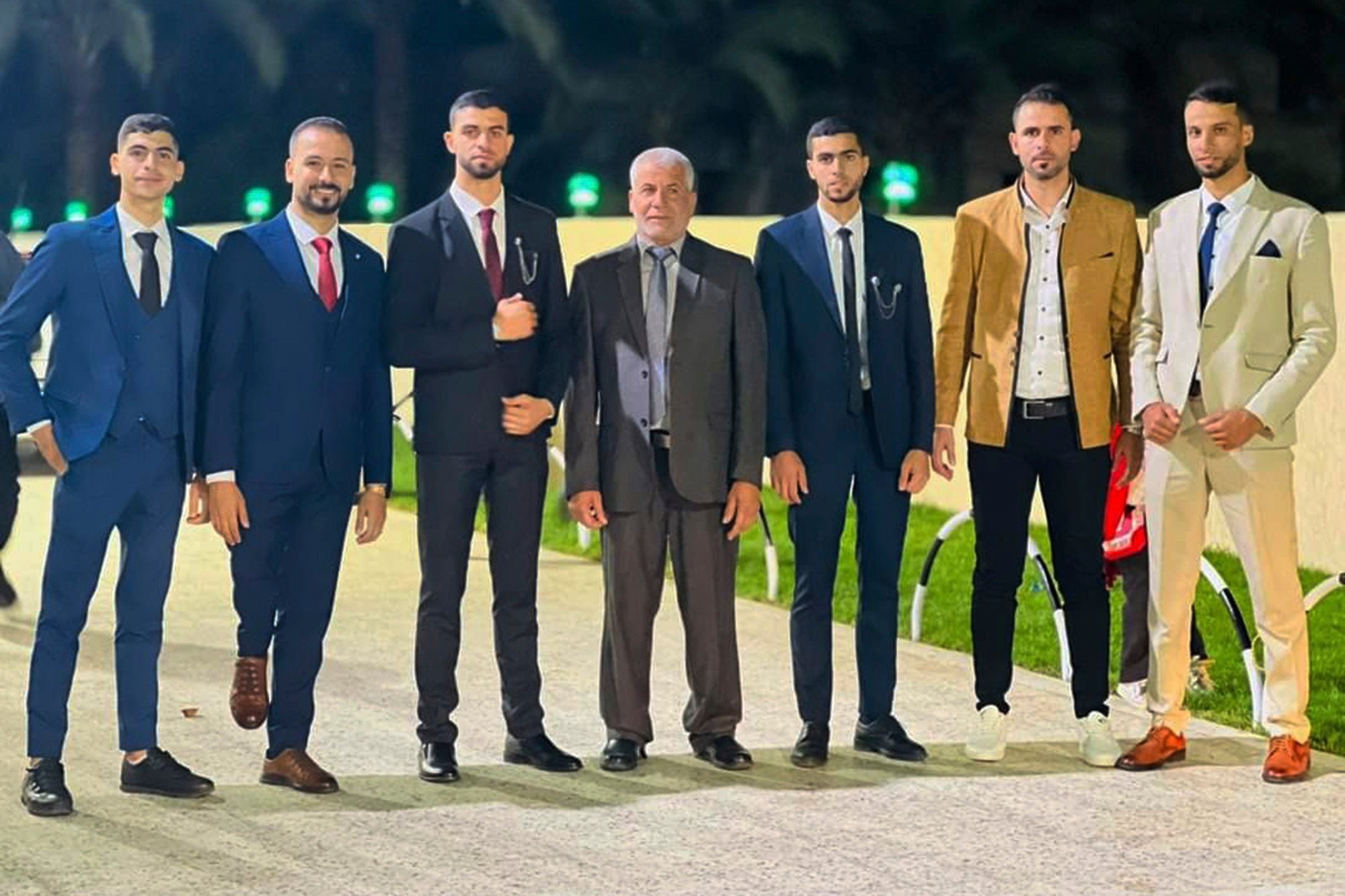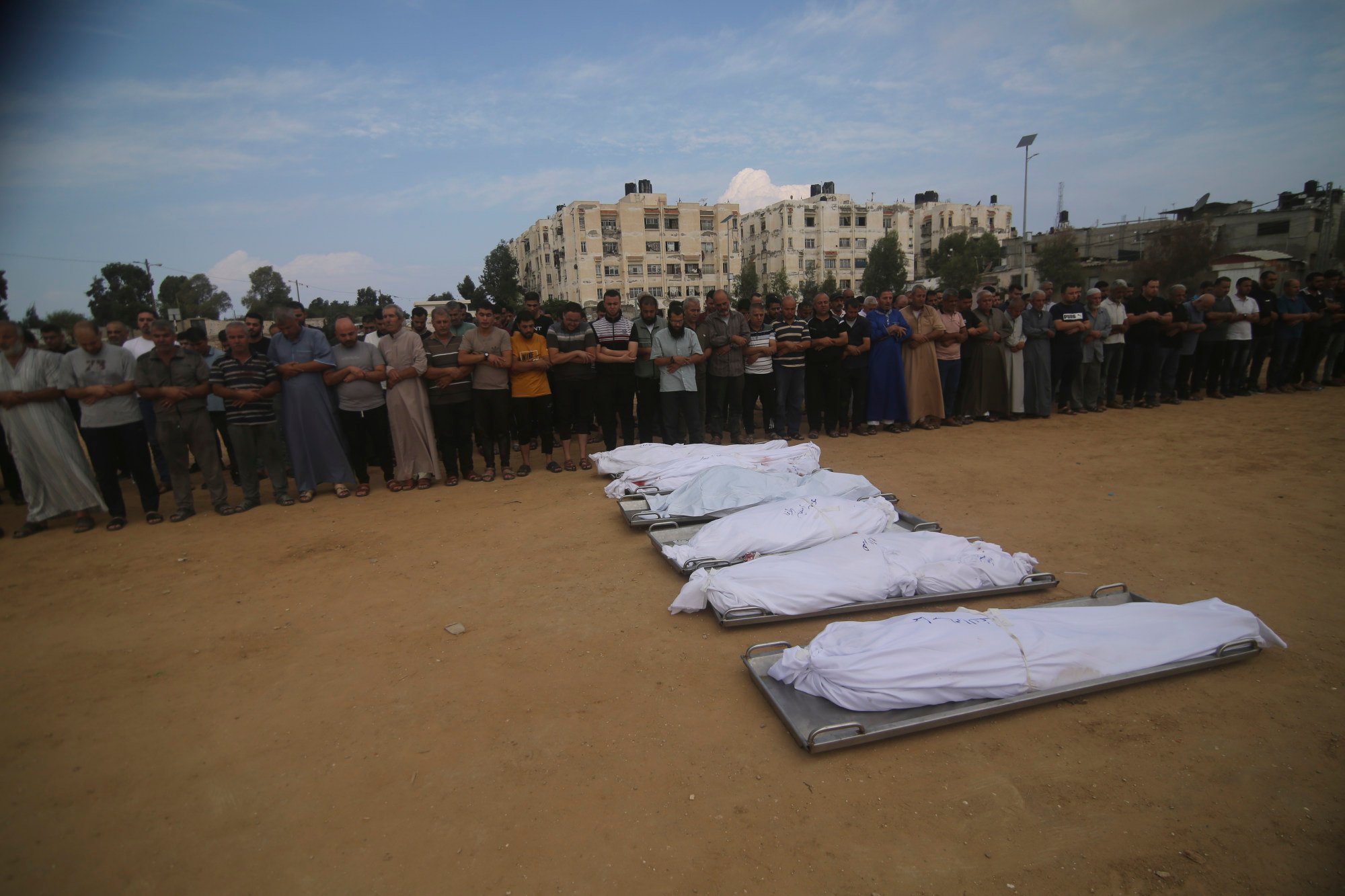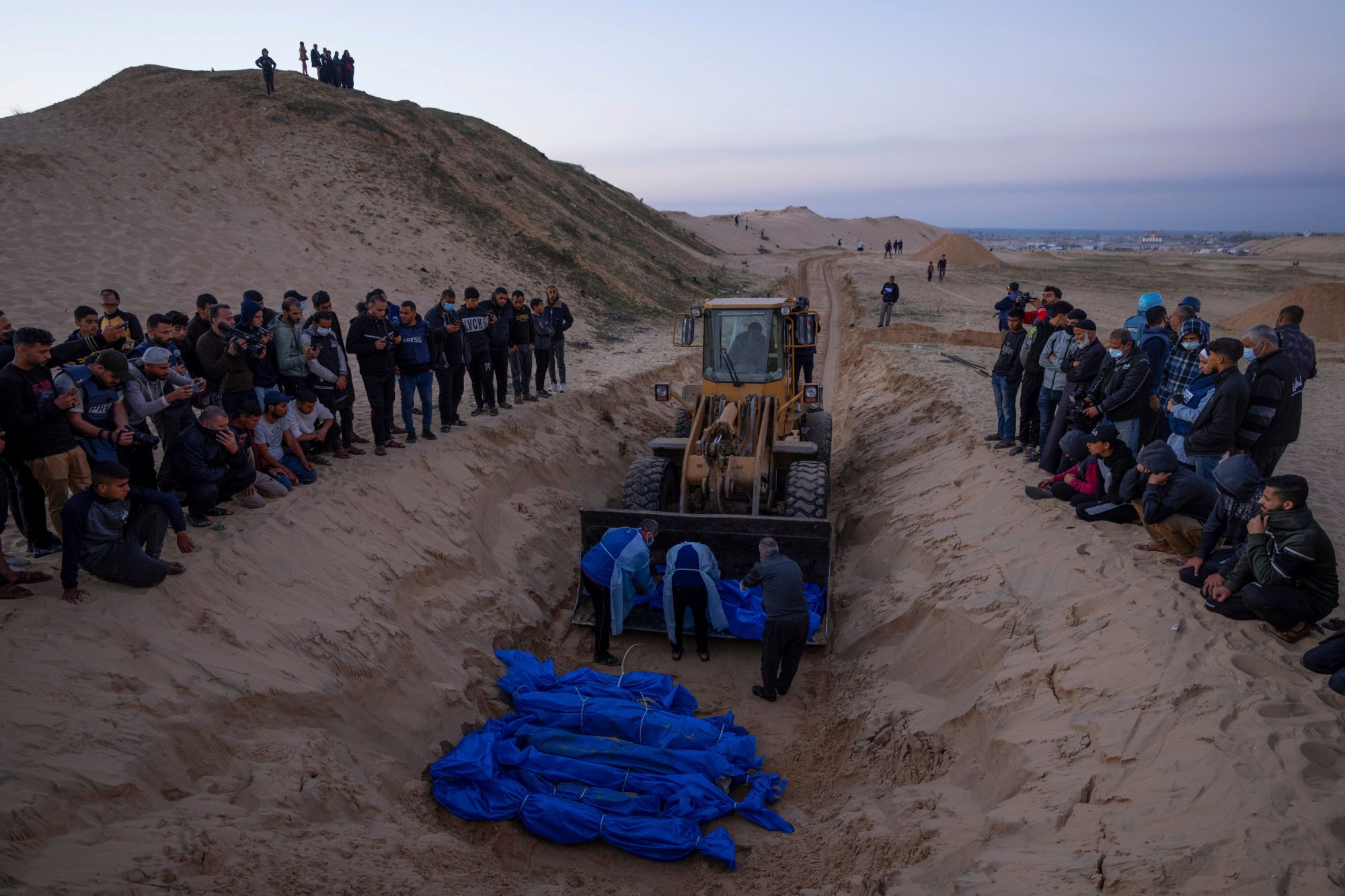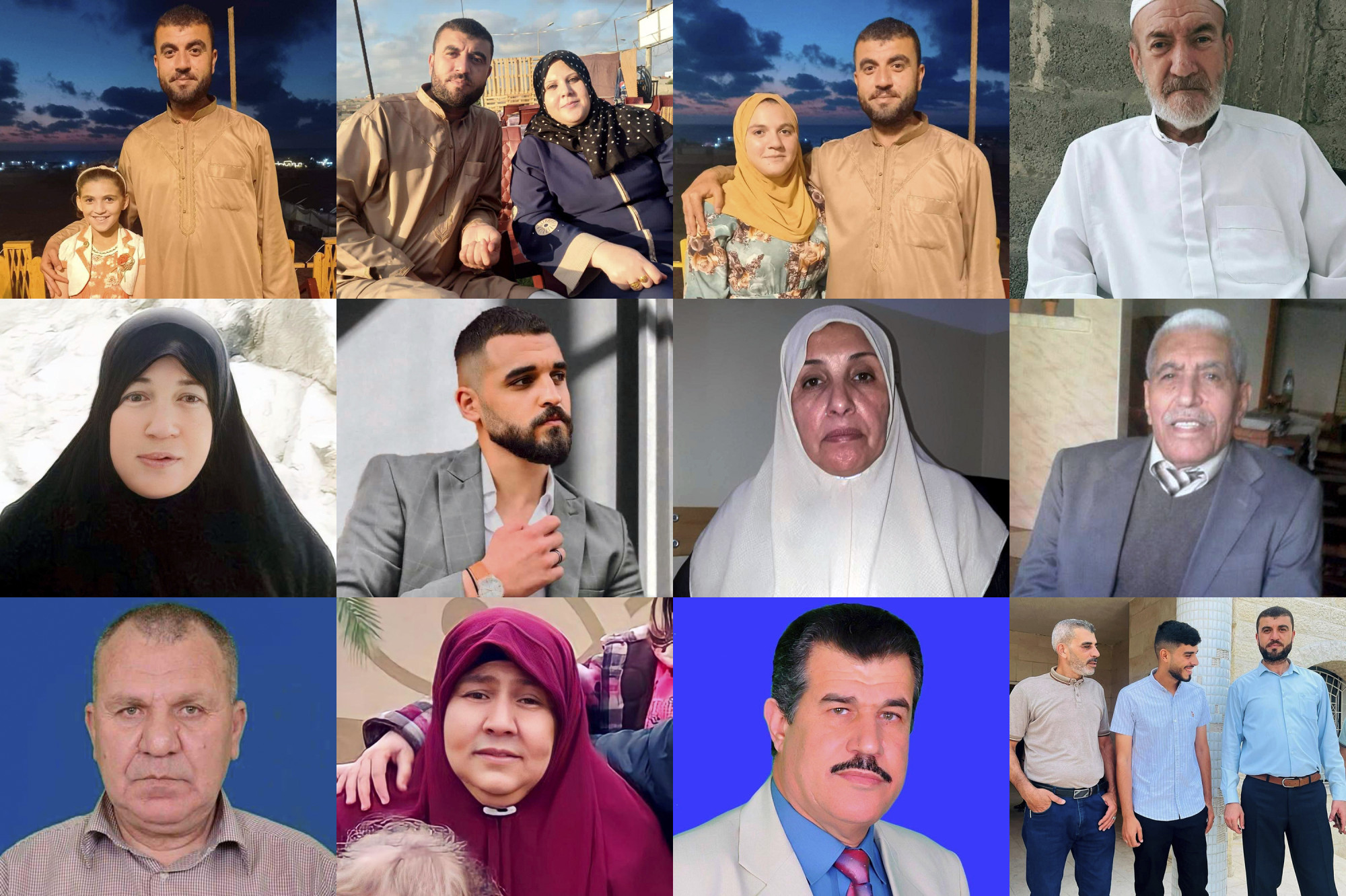AP geolocated and analysed the strikes; consulted with weapons investigators; open data-analysts and legal experts; and drew on data by Airwars, a London-based conflict monitor.
They hit residential buildings and shelters with families inside. In no case was there an obvious military target or direct warning to those inside. In one case the family said they had raised a white flag on their building in a combat zone.
This war has proven even deadlier than the displacement from Israel in 1948, said Rashid Khalidi, a Palestinian-American historian at Columbia University, when 20,000 were killed in what is known as the Nakbah, or Catastrophe.
“I don’t think anything like this has happened in modern Palestinian history,” said Khalidi.

Al-Agha family, 31 killed
On October 11, an air strike levelled Amin al-Agha’s home in western Khan Younis. The 61-year-old was asleep on the ground floor of the two-story building with his wife and three sons.
The top floor was the home of his son Muhannad al-Agha, 30, his wife Hind and their two girls, Talin, 2, and Asil, 1. The air strike killed 11 in the family, including two cousins in an adjacent building.
“It was no longer a house. It was a pile of sand,” said Jaser al-Agha, a cousin who arrived shortly after the strike.
Early October 14, an Israeli bomb struck the house of Khamis al-Agha, an employee of a Hamas-linked charity.
The three-storey building in central Khan Younis was reduced to rubble. Among the dead: Khamis al-Agha, 38, his wife, Nisreen, two sons, aged 11 and 13, two daughters, 8 and 6, and his younger brother and 9-year-old son, a cousin and her son. Only the brother’s wife survived.
On November 14, the house of Awni al-Agha, a second cousin to Khamis, was hit, destroying the three-story building in western Khan Younis. Brian Castner, weapons investigator with Amnesty International, said the damage indicated it was an air strike as well.
Only a satellite dish was sticking out above the debris. The strike killed the wife of Awni al-Agha, 64-year-old Samia; his four sons, aged between 42 and 26, his daughter Ramah, 41, her husband and two sons, aged 18 and 16.
Awni al-Agha, a government education official, survived because he had woken up for dawn prayers. Three months later, in February, Awni al-Agha died at the age of 69, most likely of a broken heart, said Jaser al-Agha.
“At times we had to create family trees to understand the civilian harm,” she said.

Abu Naja family, 20 killed
Israeli aircraft struck the homes of Abu Naja and Madi families in southern Rafah on October 17. Twenty members of Abu Naja family were immediately killed, including two pregnant women, and eight children.
The air strikes killed the 78-year-old grandmother, her granddaughter and her children. Airwars said one of the men killed was identified on Facebook as a “Mujahid” or “warrior”. His wife, pregnant sister, and her 2-year-old daughter also died.
Killing a fighter who is not participating in hostilities and is in a place crowded with civilians is considered a violation of the laws of war.
Tarzai and Souri families, 20 killed
An Israeli air strike destroyed a church building in Gaza City where hundreds of displaced were sheltering. The October 19 strike killed 20 members of the intermarried Tarzai and Souri families, from the dwindling Christian community in Gaza, including at least seven children. Ramez al-Souri lost all three children and his wife.
Israel’s military said it struck a Hamas command-and-control centre, accusing the group of embedding among civilians. It acknowledged that a church wall was damaged.
Amnesty visited the site and analysed videos, including one posted and since deleted by the Israeli army and concluded it was an air strike. Even if a military target was identified, Amnesty said, it “was reckless and therefore amounts to a war crime”.

Jabilia refugee camp, more than 130 killed
The October 31 Israeli bombing was among the deadliest of this war. Jabilia refugee camp was one of Gaza’s most densely populated areas and has been struck multiple times since October 7. The true toll remains unknown because many remain under the rubble.
Airwars named 112 civilians killed from 11 families, including 69 children and 22 women. They included at least 47 members of the Okasha and Abou al-Qoumsan families. AP identified an additional 17 from the al-Qoumsan family, where uncles, fathers and children perished.
The bombs left several craters in an area stretching for over 100 metres. Several buildings collapsed. “This is consistent of the biggest craters we’ve seen … for the last 20 years,” said Cobb-Smith.
Israel said it targeted a Hamas command-and-control centre and a Hamas battalion commander inside who would be the most senior member of the group killed so far.
Doghmush family, 44 killed
A strike on a mosque in Gaza City’s Sabra neighbourhood hit in the early evening of November 15, killing at least 44 people from the Doghmush family, including the head of the family, a 9-year-old, community leaders and two women relatives in an adjacent building.
The damage appeared limited to the mosque’s top floors. In a video taken afterward, there was no crater and the mosque appeared to have been cleaned up.
There was no sign of significant damage nearby, indicating the mosque may have been targeted directly with small aerial ammunition, said Chris Cobb-Smith, a former UN weapons inspector and British army officer who has investigated in Gaza after past wars.
The mosque was built and owned by the Doghmush family. Ragab Doghmush, whose 21-year brother was killed, said the mosque has no militant affiliation and that the family does not permit any militant activity in its neighbourhood.
A feud between Doghmush family and Hamas that dates to Hamas’ power grab in 2007 has largely kept the area off-limits to Hamas militants.

Salem family, 173 killed
Israeli air strikes destroyed two separate shelters for the Salem family on December 11 and December 19. At least 173 family members were killed, including children, at least one pregnant woman, and many elderly, among them the 87-year-old head of the family.
The December 11 air strike ripped through a block of family buildings. One was destroyed, while others lost their facades. Experts said the limited damage indicated it was a large bomb programmed to delay an explosion until after impact.
At least 80 people were killed, including multiple generations from the same bloodline. Relatives said there were no obvious combat activities nearby.
On December 19, an Israeli air strike hit another group of displaced members from the Salem family, sheltering in a villa in Rimal. The attack left a deep crater but surrounding buildings were undamaged. Survivors said tanks rolled over the rubble. At least 90 Salems were killed.
“I saw the bodies of my uncles and cousins strewn over the floor,” said Mohamed Salem, who survived the December 19 strike. “We only could identify the bodies from their IDs. They were just a pile of flesh.”
Maghazi refugee camp, at least 106 killed
Witnesses said at least four homes, hosting many displaced Palestinians, were hit directly on December 24. Body parts were strewn across the surrounding areas.
Videos showed damage consistent with air strikes. Images showed several destroyed homes in narrow alleys lined with small, mostly one-story buildings, and a large crater at the camp’s entrance.
AP had access to the post-strike hospital records that registered 106 people killed. From public death notices and partial health ministry data, AP was able to identify 36 from the Nawasreh, Abu Hamdah and Qandil families.
Israel said it was targeting Hamas militants and mistakenly struck two adjacent structures.
In the first and a rare statement to admit an errant strike, Israel said it regretted the “injury to those not involved.” It said it had taken necessary measures to avoid harm to civilians.
A military official told Kan, the Israeli public broadcaster, that the wrong weapon was used in the strike, without elaborating.

